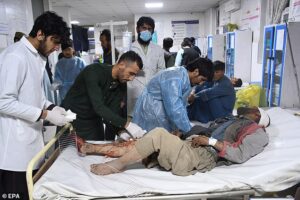The early hours of Monday morning brought devastation to northern Afghanistan, where a powerful 6.3-magnitude earthquake struck before sunrise.
The tremor killed at least 20 people and left more than 300 others injured, according to health officials, as emergency teams raced to reach the hardest-hit areas.
The Moment the Earthquake Struck
The U.S. Geological Survey reported that the quake’s epicenter was roughly 14 miles west-southwest of Khulm, striking at 12:59 a.m. local time.
It originated 17 miles below the surface, a depth strong enough to send violent tremors through nearby provinces and beyond.
Afghanistan’s Ministry of Public Health confirmed that at least 20 lives were lost, while 320 others were hurt — though most, officials say, sustained only minor injuries and were treated and released soon after.
Emergency Teams Rush to Help
In Kabul, Afghanistan’s Ministry of Defense announced that rescue teams were immediately dispatched to the affected regions, particularly Balkh and Samangan provinces, where the destruction was worst.
Teams worked through the night to transport the injured, clear debris, and help displaced families.
Taliban government spokesman Zabihullah Mujahid expressed sorrow for the loss of life, saying authorities were working “to get help to the people affected by the quake as quickly as possible.”
Damage Spreads Across Provinces
The earthquake rippled across several northern provinces, including Balkh, Samangan, and Baghlan, and was also felt as far away as Mazar-e-Sharif, the bustling capital of Balkh province.
Videos shared on social media showed damage to the city’s famed Blue Mosque, one of Afghanistan’s most cherished landmarks.
Though a few bricks crumbled from its ancient walls, the centuries-old mosque — a central site of worship and cultural gatherings — fortunately remained standing.
Disruptions on the Roads
The quake didn’t just shake homes and historic sites — it also triggered a rockslide that briefly blocked the main mountain highway connecting Kabul and Mazar-e-Sharif.
Authorities later confirmed the road had been cleared and reopened, with injured travelers rescued and taken to nearby hospitals for treatment.
The United Nations Steps In
The United Nations in Afghanistan said its teams were already on the ground, assessing the damage and delivering critical aid to affected communities.
In a statement on X (formerly Twitter), the UN expressed solidarity:
“We stand with the affected communities and will provide the necessary support.”
The quake comes only weeks after another deadly earthquake struck eastern Afghanistan, underscoring the region’s growing vulnerability to natural disasters.
A Country Struggling to Rebuild
Afghanistan has faced a series of powerful quakes in recent years — and recovery has been slow.
Much of the country’s housing is poorly constructed, made from mud bricks, wood, or unreinforced concrete, which leaves rural communities especially at risk.
Just last year, a 6.3-magnitude earthquake followed by strong aftershocks killed more than 4,000 people in western Afghanistan.
And in August 2024, another quake near the Pakistan border claimed over 2,200 lives.
Ongoing Challenges for a Shaken Nation
As rescue efforts continue, Afghanistan faces the familiar challenge of trying to rebuild with limited resources.
The country’s mountainous terrain, fragile infrastructure, and political isolation make every recovery effort harder.
For now, families across Balkh and Samangan are left sifting through the rubble, mourning loved ones, and hoping that much-needed international aid will arrive soon.
Share on Facebook «||» Share on Twitter «||» Share on Reddit «||» Share on LinkedIn
